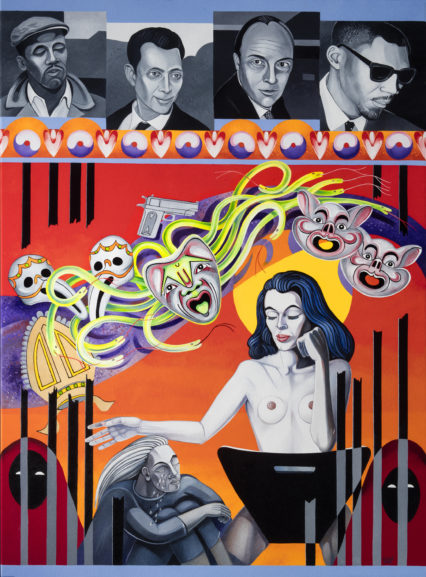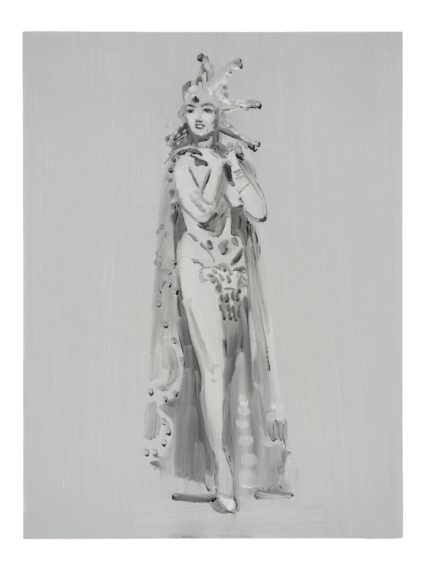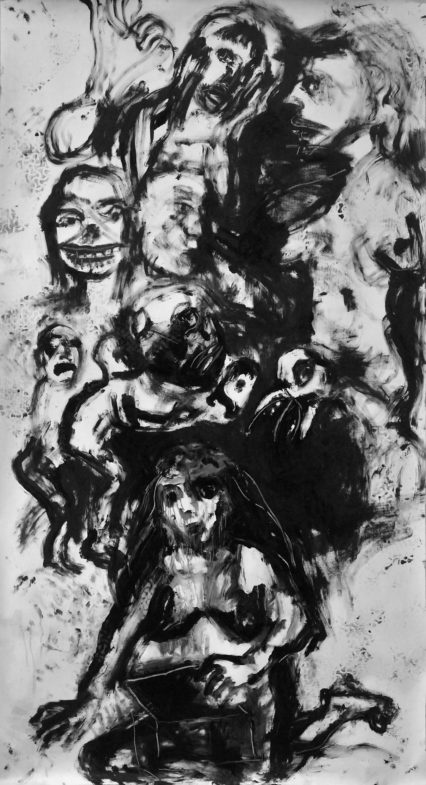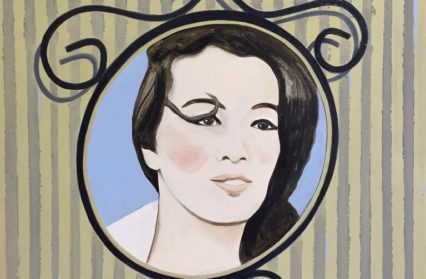‘Dear Christine’, a touring art exhibition dedicated to Christine Keeler, opens in Wales this weekend at The Elysium Gallery, Swansea. Its curator, the artist Fionn Wilson, spoke with Craig Austin about what inspired her to undertake the project, and why Keeler remains so much more than a figure of early 60s tabloid scandal.
‘The trouble is I am twenty-one, and many people consider me photogenic. I have lived in the West End of London and frequently been to parties with well-known people present. Presumably if I had been fifty-two and a housewife in Surbiton there would have been none of this trouble’

Speaking to the Daily Express in 1963, Christine Keeler found herself at the heart of the perfect storm of what came to be known as The Profumo Affair, a scandal that played out across the pages of the tabloid news. One that rocked the foundations of the British Establishment and lit the fuse for the seismic cultural and social changes that were to detonate across the rest of the decade. A period in which youth ultimately became the key, rather than the barrier, to success and in which the chintzy certainties of cosy suburbia were gleefully tossed onto the bonfire of the nation’s archaic vanities.
Yet Britain in the early 1960s remained in the stranglehold of the legacy of two world wars and was led by an Edwardian Tory Prime Minister in Harold MacMillan whose government’s policies were dedicated to tradition, hierarchy and an ultimately duplicitous obsession with old-fashioned morality. Cold War paranoia and a nascent breakdown of social boundaries culminated in the downfall of one of the country’s most revered politicians and the overnight celebrity of both Christine Keeler and Mandy Rice-Davies, the cartoon ‘good-time girls’ of tabloid infamy.
Though Profumo rebuilt his reputation via a life dedicated to philanthropy, Keeler died in 2017, impoverished and living as a virtual recluse under her new name of Sloane. Institutionally scapegoated because of her dirt-poor background as much as by her gender, Keeler now finds herself the subject of a touring exhibition, Dear Christine, that seeks to explore a broader and deeper understanding of a woman who, over half a century later, continues to divide and beguile in equal measures.

‘Christine Keeler has always fascinated me,’ its curator Fionn Wilson reflects, ‘since I first became aware of her story via the 1989 film Scandal. When I started painting I decide to do a series of paintings of her, and as I researched Christine’s life story it struck me that even though she is a culturally significant figure in British history there is very little recent artistic reference to her. I decided that I would try to rectify this and add to the visual narrative around her. And so the project was born. It’s also a very personal project. I have great sympathy for Christine Keeler.’
Though the historic sexual exploitation of Keeler might align her experience with the focus and aims of the #MeToo movement it is the issue of social class that Wilson sees as key to Keeler’s life experience, and the pivotal life events that emanated from her poverty-stricken upbringing: ‘I can see the temptation to draw parallels with #MeToo, but for me it’s much more about class. The abuse that Keeler had to face, being called a slapper or a tart, is the exact same abuse that is levelled at working class women today and I find that far more of a compelling focus. There are a lot of themes that are relevant to today but she’s also very interesting in herself as a person, within her own context and her own time. The temptation is to make her seem to be completely relevant to today, which of course she is, but she also has her own particular place within that time and culture.’
‘Her beauty was a kind of escape route. At the time, as a woman you’d either get married at an early age or end up in a shitty unfulfilling job, but there was something about Christine that simply refused to compromise; that notion of running away to London where the streets were supposedly paved with gold. Her beauty acted as a kind of passport, but she didn’t just cross class boundaries, she crossed race boundaries too. The 60s was a period of extreme racial tension, yet she was sleeping with black men at the same time as she was sleeping with Profumo; to many at the time an even bigger scandal! She had no shame about that, nor should she, but people simply couldn’t get their heads around it. The fallout from the scandal itself affected the rest of Christine’s life and, as she said, she could never escape it. The tabloid press treated her viciously, yet the male protagonists seemed to escape this and ultimately fared much better. The press continued to hunt her and feature the occasional expose of her as an older woman, comparing her cruelly to the more glamorous images of her younger self.’

‘There was a real malevolent glee in the way that the tabloids treated her at the time,’ Wilson continues. ‘The term for it now is slut-shaming, yet another thing targeted almost solely towards young working-class women. The People’s front-page headlines at the time was actually “Keeler, The Shameless Slut”, and spoke of “an empty-headed trollop skilled only in using her body to bewitch and betray”. You wouldn’t get away with using that language now of course, and things have got a lot better for women in society as a whole; but there is still this fascination with supposedly “loose women”, a desire to categorise women as either mother, whore, or hag, with almost nothing in between. The exhibition represents themes that are still relevant to this day, not least class, power and the politics of sex. The participating artists are women who offer their own perspective on a narrative that has mostly been led by men.’
Pauline Boty, a founder of the British Pop movement, painted Keeler in the lost work ‘Scandal 63’ and as part of Dear Christine, artist, feminist and activist Caroline Coon will be exhibiting an homage to the missing painting. Previously unseen photographs will also be on display courtesy of James Birch, a renowned curator and personal friend of Keeler’s, along with Shani Rhys James’ ‘Christine’ and ‘Pandora’s iPad‘. A personal favourite of this writer being ‘Laughing While Smashing (for Mandy and Christine)‘ by Roxana Halls, a painting in oil in which the artist fantasises that ‘Keeler comes to survey her oppressors with a measure of Rice-Davies’ insouciance and that together they grant themselves some form of fitting, liberating revenge. In paint, at least, I can bestow them this’.
Unique to the Swansea leg of the ‘Dear Christine’ exhibition is a poetry event of readings of new work from Welsh poets who have written about Keeler; an extensive array of talent that includes Kathryn Gray, Natalie Ann Holborow, Patrick Jones and Jo Mazelis. ‘I did some research on the South Wales poetry scene’ Wilson explains, ‘and though I wanted to work with female poets I didn’t want that to be at the exclusion of men. Patrick Jones was really keen to be involved and though I did directly approach a number of male poets a few of them spoke to me quite candidly, and to their credit, about not feeling that they were able to speak on behalf of Christine Keeler. I asked around the scene and I was really struck by the generosity that was shown between and to fellow poets, suggesting others who might want to be involved. A community spirit I found to be really quite refreshing and rare, a real sense of genuine camaraderie.’
‘I’m really excited about bringing the exhibition to Wales and to exploring Christine’s life and story though this additional form of artistic expression’ Wilson continues. ‘It’s a very personal project, an opportunity to add to her legacy in a cultural sense. I want people to appreciate her for the woman that she was and the life that she led. The victors may write history, but we can rewrite it’.
Featured Image: ‘Welcome to the Sixties’ by Cathy Lomax
‘Dear Christine’ – a tribute to Christine Keeler, is at The Elysium Gallery and runs to 9 November as part of The Swansea Fringe.
‘Dear Christine’ will continue, and conclude, at the ARTHOUSE1 Gallery, London SE1 from 2–29 Feb, 2020
A six-part drama series ‘The Trial of Christine Keeler’ will be screened by the BBC at the end of 2019
You might also like…
Nick Hornby has brought his Wonderland to the MOSTYN Gallery in Llandudno with Zygotes and Confessions. Here, Amy Briscoe reviews the dream-like exhibition, which is currently attracting an international audience online.
Craig Austin is a regular contributor to Wales Arts Review.












